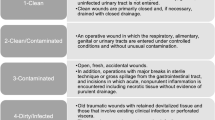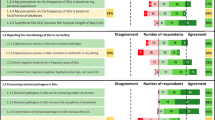Abstract
Background
The utility of Gram stains in diagnosing periprosthetic infections following total hip arthroplasty has recently been questioned. Several studies report low sensitivity of the test, and its poor ability to either confirm or rule out infection in patients undergoing revision total hip arthroplasty. Despite this, many institutions including that of the senior author continue to perform Gram stains during revision total hip arthroplasty.
Questions/purposes
We assessed the sensitivity, specificity, accuracy, and positive and negative predictive values of Gram stains from surgical-site samplings taken from procedures on patients with both infected and aseptic revision total hip arthroplasties.
Methods
A review was performed on patients who underwent revision total hip arthroplasty between 2000 and 2007. Eighty-two Gram stains were performed on patients who had infected total hip arthroplasties and underwent revision procedures. Additionally, of the 410 revision total hip arthroplasties performed on patients who were confirmed infection-free, 120 Gram stains were performed. Patients were diagnosed as infected using multiple criteria at the time of surgery. Sensitivity, specificity, positive and negative predictive values, and accuracy were calculated from these Gram stain results.
Results
The Gram stain demonstrated a sensitivity and specificity of 9.8% and 100%, respectively. In this series, the Gram stain had a negative predictive value of 62%, a positive predictive value of 100%, and an accuracy of 63%.
Conclusions
Gram stains obtained from surgical-site samples had poor sensitivity and poor negative predictive value. Based on these findings, as well as those of other authors, we believe that Gram stains should no longer be considered for diagnosing infections in revision total hip arthroplasty.
Level of Evidence
Level III, diagnostic study. See Guidelines for Authors for a complete description of levels of evidence.
Similar content being viewed by others
References
Athanasou JA, Pandey R, DeSteiger R, Crook D, McLardy-Smith P. Diagnosis of infection by frozen section during revision arthroplasty. J Bone Joint Surg Br. 1995;77:28–33.
Atkins BL, Athanosou N, Deeks JJ, Crook DWM, Simpson H, Peto TEA, McLardy-Smith P, Berendt AR. Prospective evaluation of criteria for microbiological diagnosis of prosthetic-joint infection at revision arthroplasty. J Clin Micro. 1998;36:2932–2939.
Banit DM, Kaufer H, Fartford JM. Intraoperative frozen section analysis in revision total joint arthroplasty. Clin Orthop Relat Res. 2002;401:230–238.
Bauer TW, Parvizi J, Kobayashi N, Krebs V. Diagnosis of periprosthetic infection. J Bone Joint Surg Am. 2006;88:869–882.
Bernard L, Lubbeke A, Stern R, Bru JP, Feron JM, Peyramond D, Denormandie P, Arvieux C, Chirouze C, Perronne C, Hoffmeyer P. Value of preoperative investigations in diagnosing prosthetic joint infection: retrospective cohort study and literature review. Scan J Infect Dis. 2004;36:410–416.
Bori G, Soriano A, Garcia S, Gallart X, Mallofre C, Mensa J. Neutrophils in frozen section and type of microorganism isolated at the time of resection arthroplasty for the treatment of infection. Arch Orthop Trauma Surg. 2009;129:591–595.
Bori G, Soriano A, Garcia S, Mallofre C, Riba J, Mensa J. Usefulness of histological analysis for predicting the presence of microorganisms at the time of reimplantation after hip resection arthroplasty for the treatment of infection. J Bone Joint Surg Am. 2007;89:1232–1237.
Chimento GF, Finger S, Barrack RL. Gram stain detection of infection during revision arthroplasty. J Bone Joint Surg Br. 1996;78:838–839.
DellaValle CJ. Periprosthetic sepsis. Clin Orthop Relat Res. 2004;420:26–31.
Della Valle CJ, Bogner E, Desai P, Lonner JH, Adler E, Zuckerman JD, Di Cesare PE. Analysis of frozen sections of intraoperative specimens obtained at the time of reoperation after hip or knee resection arthroplasty for the treatment of infection. J Bone Joint Surg Am. 1999;81:684–689.
DellaValle CJ, Scher DM, Kim YH, Oxley CM, Desai P, Zuckerman JD, DiCesare PE. The role of intraoperative Gram stain in revision total joint arthroplasty. J Arthroplasty. 1999;14:500–504.
Garvin KL, Hanssen AD. Current Concepts Review: infection after total hip arthroplasty: past, present and future. J Bone Joint Surg Am. 1995;77:1576–1588.
Ghanem E, Ketonis C, Restrepo C, Joshi A, Barrack R, Parvizi J. Periprosthetic infection: where do we stand with regard to Gram stain? Acta Ortho. 2009;80:37–40.
Ghanem E, Parvizi J, Burnett RSJ, Sharkey PF, Keshavarzi N, Aggarwal A, Barrack RL. Cell count and differential of aspirated fluid in the diagnosis of infection at the site of total knee arthroplasty. J Bone Joint Surg Am. 2008;90:1637–1643.
Hughes PW, Salvati EA, Wilson PD, Blumenfeld EL. Treatment of subacute sepsis of the hip by antibiotics and joint replacement criteria for diagnosis with evaluation of twenty-six cases. Clin Orthop Relat Res. 1979;141:143–157.
Ko OS, Ip D, Chow KP, Cheung F, Lee OB, Lam JJ. The role of intraoperative frozen section in decision making in revision hip and knee arthroplasties in a local community hospital. J Arthroplasty. 2005;20:189–195.
Kraemer WJ, Saplys R, Waddell JP, Morton J. Bone scan, gallium scan, and hip aspiration in the diagnosis of infected total hip arthroplasty. J Arthroplasty. 1993;8:611–616.
Lachiewicz PF, Rodgers GD, Thomason HC. Aspiration of the hip joint before revision total hip arthroplasty. Clinical and laboratory factors influencing attainment of a positive culture. J Bone Joint Surg. 1996;78:749–754.
Leone JM, Hanssen AD. Management of infection at the site of a total knee arthroplasty. J Bone Joint Surg Am. 2005;87:2335–2348.
Lonner JH, Desai P, Dicesare PE, Steiner G, Zuckerman JD. The reliability of analysis of intraoperative frozen sections for identifying active infection during revision hip or knee arthroplasty. J Bone Joint Surg Am. 1996;78:1553–1558.
Pandey R, Drakoulakis E, Athanasou NA. An assessment of the histological crtiteria used to diagnose infection in hip revision arthroplasty tissues. J Clin Path. 1999;52:118–123.
Schinsky MF, DellaValle CJ, Sporer SM, Paprosky WG. Perioperative testing for joint infection in patients undergoing revision total hip arthroplasty. J Bone Joint Surg Am. 2008;90:1869–1875.
Spangehl MJ, Masri BA, O’Connell JX, Duncan CP. Prospective analysis of preoperative and intraoperative investigations for the diagnosis of infection at the sites of two hundred and two revision total hip arthroplasties. J Bone Joint Surg Am. 1999;81:672–683.
Spangehl MJ, Masterson E, Mastri BA, O’Connell JC, Duncan CP. The role of intraoperative Gram stain in the diagnosis of infection during revision total hip arthroplasty. J Arthroplasty. 1999;14:952–956.
Author information
Authors and Affiliations
Corresponding author
Additional information
One of the authors (MAM) is a consultant for Stryker Orthopaedics, Mahwah, NJ, and Wright Medical Technologies, Inc, Arlington, TN, and receives royalties from Stryker Orthopaedics.
Each author certifies that his or her institution approved the human protocol for this investigation and that all investigations were conducted in conformity with ethical principles of research, and that informed consent for participation in the study was obtained.
About this article
Cite this article
Johnson, A.J., Zywiel, M.G., Stroh, D.A. et al. Should Gram Stains Have a Role in Diagnosing Hip Arthroplasty Infections?. Clin Orthop Relat Res 468, 2387–2391 (2010). https://doi.org/10.1007/s11999-009-1216-9
Published:
Issue Date:
DOI: https://doi.org/10.1007/s11999-009-1216-9




